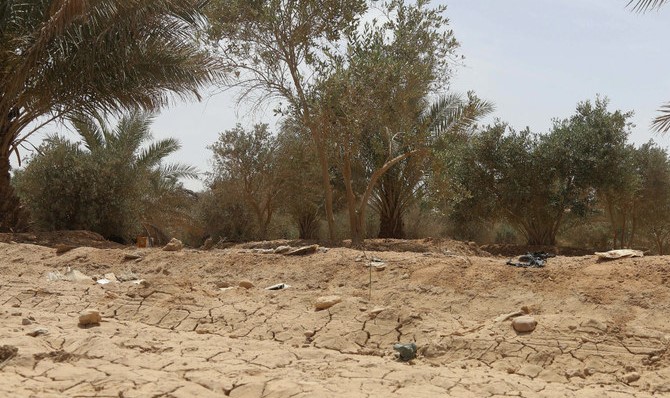
- ARAB NEWS
- 12 Jul 2025

As the world marked International Day Against Desertification and Drought on June 17, a report by the UN outlined the threat that humanity faces from rising desertification and serious droughts, which now seem to be a commonplace occurrence.
The UN says that droughts are the biggest threat to sustainable development and forecasts that they might affect more than 75 percent of the world’s population by the year 2050. This dire warning seems to be playing out in the real world even today, as the number and duration of droughts has increased by 29 percent since 2000. More than 2.3 billion people, about a third of the global population, already face water stress.
Another stark prediction is that, by 2040, almost 25 percent of the world’s children are likely to live in areas affected by extreme weather events and that no country in the world is immune to drought.
Even more seriously, desertification is no longer only a problem for countries that are home to deserts or are in arid or semi-arid regions. As large parts of the world begin to dry up, it leads to serious erosion of the topsoil, which either gets washed away by sudden downpours or is simply blown away by furious windstorms, which are also becoming increasingly frequent. This means that no part of the world is now protected from the effects of extreme weather events elsewhere, however far away they may be. An example is that, every year, 60 million tons of sand is carried by windstorms from the Sahara Desert in Africa all the way to the Caribbean islands, almost 9,000 km away.
Unfortunately, it is not just nature to blame for the rising desertification across the world. Invariably, as with almost every other environmental problem, human activity is a bigger threat, accelerating the process of desertification and droughts each year.
More than 33 percent of the world’s land surface is arid and hence extremely vulnerable to overexploitation and inappropriate use. Omnipresent challenges like poverty, deforestation, overgrazing and bad irrigation practices are all major factors propelling the process of desertification.
Add in the vagaries of the climate, induced by global warming, and one gets a heady cocktail that is driving the world to an eternal state of desertification. In many ways, we seem to be caught in a vicious circle, in which one negative factor feeds another and so on.
No part of the world is now protected from the effects of extreme weather events elsewhere, however far away they may be.
Ranvir S. Nayar
For instance, climate change and low rainfall lead to increased deforestation and overgrazing as the poor struggle to feed themselves and their animals. Low rainfall also makes the privileged few who have access to irrigation overuse the limited water that exists in order to get a proper harvest. A poor harvest in turn drives up poverty and, the poorer the people become, the more desperate they are and hence they use the few natural resources they still have access to in an even more intense manner, worsening the problem.
Droughts and desertification do not only have economic consequences. They also lead to death and destitution. According to the UN, between 1970 and 2019, drought was one of the biggest factors behind human losses, accounting for about 650,000 deaths. Moreover, drought and desertification also have long-term social consequences, such as by forcing entire communities to migrate to areas with access to water.
Forced migration is also said to be one of the leading causes of poverty, social strife and often violence, as can be seen in several parts of Africa. There, clashes between various communities seem to be rising in frequency, especially when it involves the migration of one community to another area, mainly in search of land to cultivate or to find jobs.
As with practically every other issue of humankind, droughts and desertification impact women and girls in a far more serious manner than males. One example is that, in many Asian and African countries, it is supposed to be the job of the women of the house, however young or old they may be, to fetch water for everyday use. As the water source can be several kilometers away, it means that girls have to forgo their schooling in order to ensure there is enough water to feed and wash the whole family. Droughts and heat waves make these treks far longer and more arduous, impacting the health and well-being of the girls and women, besides taking up a large part of their days.
Drought and desertification are also the biggest threats to crops and cattle, as more than 55 million people are impacted by them. Though developing countries have traditionally been more vulnerable, both desertification and drought are now familiar phrases even in the developed world. Large parts of southern Spain and portions of Portugal have been facing intense heat waves and droughts for many years, leading to a rapid rise in desertification in these two countries. Thousands of acres of once-fertile land in these countries have turned fallow. The same fate has also befallen large tracts of land in various parts of the US, notably in California, Texas and Florida. According to the US government, almost 40 percent of land in the country, notably in the west, is believed to be highly vulnerable to desertification, as it is arid or semi-arid.
Though there are no easy solutions to fend off desertification and drought, the only way out for the global community is to work together. The rich countries definitely have access to better technologies and far more financial resources to tackle these problems. These should not just be for themselves, but also to help the poorer nations. Only when lands that have been lost to degradation are restored can the problem of desertification be slowed down, if not reversed.
• Ranvir S. Nayar is managing editor of Media India Group.